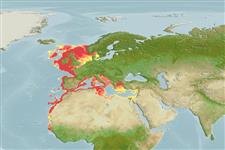Elasmobranchii (tubarões e raias) (sharks and rays) >
Carcharhiniformes (Ground sharks) >
Scyliorhinidae (Cat sharks)
Etymology: Scyliorhinus: Greek, skylla = a kind of shark + Greek, rhinos = nose (Ref. 45335).
Ambiente / Clima / Intervalo
Ecologia
; marinhas demersal; intervalo de profundidade 10 - 780 m (Ref. 56504), usually 80 - 100 m (Ref. 81056). Subtropical, preferred 21°C (Ref. 107945); 63°N - 12°N, 18°W - 36°E
Northeast Atlantic: Norway and British Isles south to Senegal, including the Mediterranean. Possibly Côte d'Ivoire. Some populational differences exist between Catulus duhameli (a name for the Mediterranean canicula based on size) and this species which may eventually be expressed as subspecies. The only reported observation of this species in Crimean waters was in 1937, which is possibly erroneous (Ref. 897).
Length at first maturity / Tamanho / Peso / Idade
Maturity: Lm 57.0, range 41 - 64 cm
Max length : 100.0 cm TL macho/indeterminado; (Ref. 244); common length : 60.0 cm TL macho/indeterminado; (Ref. 4645); Peso máx. publicado: 1.3 kg (Ref. 40637); Idade máx. registada: 12 anos (Ref. 81067)
Espinhos dorsais (total): 0; Raios dorsais moles (total): 0; Espinhos anais 0; Raios anais moles: 0. A slender, dark-spotted catshark with 8-9 dusky saddles (often obscure or absent), greatly expanded anterior nasal flaps, reaching mouth and covering shallow nasoral grooves, labial furrows on lower jaw only, first dorsal fin originates well behind the pelvic fins, second dorsal fin much smaller than first (Ref. 244).
Most common catshark in coastal waters of Europe (Ref. 32804). Inhabits continental shelves and uppermost slopes. Found on sandy, coralline, algal, gravel or muddy bottoms. Occurs mainly between 10-100 m depth in the northeast Atlantic and up to 400 m depth in the Mediterranean Sea (Ref. 88187) and from 288-780 m in the eastern Ionian Sea (Ref. 56504). They sometimes occur in midwater. Nocturnal species, males resting on substrate and females hiding in shallow (0.5-1.5 m depth) caves and crevices during the day (Ref. 88835). Feed on a variety of benthic invertebrates, including mollusks, crustaceans, small cephalopods, polychaete worms, and small bony fishes (Ref. 244, 11889). Males have been found to forage in shallow prey-rich areas with soft sediment or areas covered with filamentous algae (Ref. 88836). Oviparous, with a single egg laid per oviduct at a time. Detect weak electric fields generated by other organisms (e.g. potential prey) (Ref. 10311). Utilized fresh and dried-salted for human consumption, also for oil and fishmeal.
Oviparous, laying paired eggs (one per oviduct) in shallow subtidal areas, although some egg cases have been found in the deeper part of intertidal zones (Ref. 244). Embryos feed solely on yolk (Ref. 50449). The egg cases are anchored to macroalgae, sea grass or sessile erect invertebrates such as poriferans, bryozoans and hydroids (Ref. 32804, 58137). The capsules have tendrils at each corner used for anchorage purposes. Egg capsule size varies according to locality and female size (Ref. 244) and ranges between 4.9-7.0 cm length and 1.5-3.0 cm width (Ref. 88837). Egg cases may be deposited throughout the year, peaking in June and July (Ref. 32804). Recent studies estimate fecundity of females from the northeast Atlantic to be at around 29-62 pups (Ref. 32804). Fully formed pups hatch after 5-11 months, depending on water temperature (Ref. 244, 32804). Newly hatched pups are about 8-10 cm in length (Ref. 78469).
Compagno, L.J.V., 1984. FAO Species Catalogue. Vol. 4. Sharks of the world. An annotated and illustrated catalogue of shark species known to date. Part 2 - Carcharhiniformes. FAO Fish. Synop. 125(4/2):251-655. Rome: FAO. (Ref. 244)
Categoria na Lista Vermelha da IUCN (Ref. 115185)
CITES (Ref. 94142)
Not Evaluated
Ameaça para o homem
Harmless
Utilização humana
Pescarias: pouco comercial
Mais informação
ReferênciasAquaculturaPerfil para aquaculturaEstirpesGenéticaFrequência dos alelosHereditariedadeDoençasProcessamentoMass conversion
Ferramentas
Relatórios especiais
Descarregue XML
Fontes da internet
